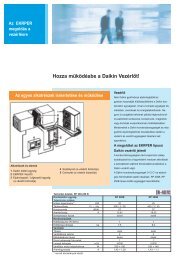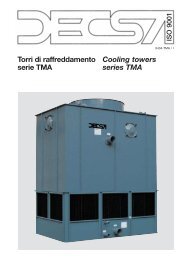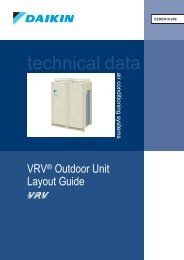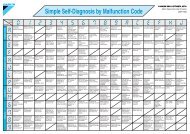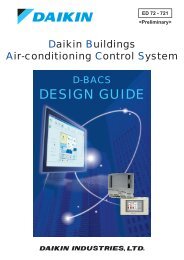VRV IV sets the standard …again - Daikin
VRV IV sets the standard …again - Daikin
VRV IV sets the standard …again - Daikin
You also want an ePaper? Increase the reach of your titles
YUMPU automatically turns print PDFs into web optimized ePapers that Google loves.
<strong>Daikin</strong> leads <strong>the</strong> way…<br />
Seasonal efficiency, Smart use of energy<br />
Challenging 20-20-20 environmental targets<br />
The European Commission has set challenging targets for improving energy efficiency in <strong>the</strong> EU. These so-called 20-20-20 targets aim at<br />
a 20% reduction in CO 2 emissions, 20% more renewable energy and a 20% reduction in <strong>the</strong> use of primary energy, all by <strong>the</strong> year 2020.<br />
To realise <strong>the</strong>se objectives, Europe issued <strong>the</strong> Eco-Design Directive [2009/125/EC]. This <strong>sets</strong> minimum efficiency requirements for energy<br />
related products. After 2013, all air conditioners and air to air heat pumps under 12 kW come into scope of this Eco-Design Directive. From<br />
2013, products unable to comply with <strong>the</strong> minimum efficiency requirement (such as non-inverter air conditioners) will lose <strong>the</strong>ir CE<br />
marking and thus may no longer be sold in Europe. In 2014 <strong>the</strong> energy-performance bar will again be raised significantly.<br />
Major change: seasonal efficiency in line with real-life performance<br />
Not only does <strong>the</strong> Eco-Design Directive systematically raise <strong>the</strong> minimum requirements with respect to environmental performance, <strong>the</strong><br />
method used to measure this performance has also been changed to better reflect real-life conditions. Previous measurements reflected<br />
so-called nominal efficiency, a measurement of performance at one fixed outdoor temperature and with equipment running at full power.<br />
Since a cooling or heating season involves a range of outdoor temperatures (not just <strong>the</strong> one nominal temperature in <strong>the</strong> rating) and<br />
equipment is often only running at partial load, this old rating did not properly reflect actual performance.<br />
The new method, seasonal efficiency, measures heating and cooling performance across a range of outdoor temperatures that give<br />
a better representation of actual efficiency over an entire heating or cooling season. Moreover, auxiliary modes such as stand-by mode<br />
are also taken into account in <strong>the</strong> new seasonal efficiency ratings. Thus seasonal efficiency gives a much better representation of <strong>the</strong> real<br />
performance of an air conditioner, in real-life conditions, across an entire season.<br />
Temperature<br />
NOMINAL SEASONAL<br />
1 Temperature condition: Several rating<br />
35°C for cooling temperatures<br />
7°C for heating for cooling and heating,<br />
Does not often occur in<br />
reality<br />
reflecting actual<br />
performance over an<br />
entire season<br />
CAPACITY<br />
10 20 30 40 50 60 70 80 90 100<br />
Capacity<br />
NOMINAL SEASONAL<br />
Does not reflect Integrates operation at<br />
partial capacity partial instead of full<br />
Benefits of inverter<br />
capacity<br />
technology not visible Benefits of inverter<br />
technology are shown<br />
Europe’s new energy label: raising <strong>the</strong> bar on energy efficiency<br />
To inform consumers concerning <strong>the</strong>se new energy performance <strong>standard</strong>s, Europe is also introducing a new energy<br />
label. The present European energy label, introduced in 1992, has had its effect. Consumers are able to compare and<br />
make purchasing decisions based on uniform labelling criteria. The new label that will come into force on 1 January<br />
2013 will allow end-users to make even better informed choices, since seasonal efficiency reflects air conditioner<br />
efficiency over an entire season.<br />
The new energy label includes multiple classifications from A+++ to D reflected in colour shadings ranging from dark<br />
green (most energy efficient) to red (least efficient). Information on <strong>the</strong> new label includes not only <strong>the</strong> new seasonal<br />
efficiency ratings for heating (SCOP) and cooling (SEER), but also annual energy consumption and sound levels.<br />
<strong>Daikin</strong> leading <strong>the</strong> way to seasonal efficiency<br />
While <strong>the</strong> challenges of Eco-Design are immense, <strong>Daikin</strong> has resolutely chosen for early implementation of this<br />
new legislation. Already in 2010, <strong>Daikin</strong> launched a new light commercial range fully optimised for seasonal<br />
efficiency. The Seasonal Smart series in this range in fact already complies with <strong>the</strong> very challenging 2014 minimum<br />
requirements. Today <strong>Daikin</strong> is proud to indicate <strong>the</strong> seasonal performance of its entire residential and light<br />
commercial range up to 12 kW.<br />
9<br />
NOMINAL SEASONAL<br />
Does not take<br />
auxiliary power modes<br />
into account<br />
Auxiliary modes<br />
Includes consumption<br />
auxiliary modes:<br />
• Thermostat off<br />
• Standby mode<br />
• OFF mode<br />
• Crankcase heater<br />
Nominal efficiency gives an indication on how efficient an air conditioner is when operating in a nominal condition.<br />
Seasonal efficiency gives an indication on how efficient an air conditioner is when operating over an entire cooling or heating season.



